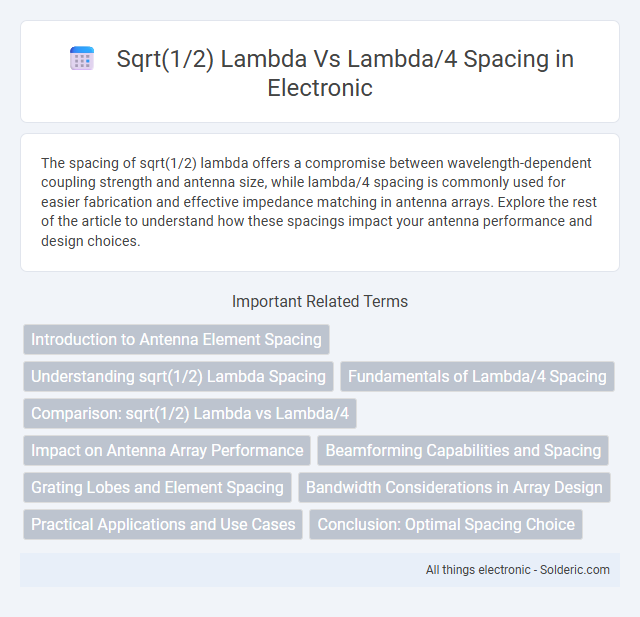The spacing of sqrt(1/2) lambda offers a compromise between wavelength-dependent coupling strength and antenna size, while lambda/4 spacing is commonly used for easier fabrication and effective impedance matching in antenna arrays. Explore the rest of the article to understand how these spacings impact your antenna performance and design choices.
Comparison Table
| Parameter | (1/2) l Spacing | l/4 Spacing |
|---|---|---|
| Element Spacing | Approximately 0.707 l | 0.25 l |
| Grating Lobes | Minimal risk; spacing < l | No grating lobes; very safe spacing |
| Mutual Coupling | Moderate coupling effect | Higher coupling due to close proximity |
| Array Size | Medium array length for fixed element count | Longer array length for fixed element count |
| Beamwidth | Narrower beams achievable | Broader beams due to increased total array length |
| Implementation Complexity | Standard, balanced design | Requires precise manufacturing due to smaller gaps |
Introduction to Antenna Element Spacing
Element spacing in antenna arrays significantly influences beamforming performance and mutual coupling effects. Spacing at (1/2) l (approximately 0.707 l) reduces grating lobes while maintaining efficient radiation patterns, offering a compromise between resolution and array size. In contrast, l/4 spacing minimizes element interactions but may limit directivity and increase array complexity for equivalent aperture size.
Understanding sqrt(1/2) Lambda Spacing
(1/2)l spacing refers to antenna or element spacing that is approximately 0.707 times the wavelength (l), offering a balance between element coupling and array size. This spacing reduces mutual coupling effects compared to l/4 spacing, which is only 0.25l and leads to stronger interactions and potential performance degradation. Understanding (1/2)l spacing is crucial in antenna array design for optimizing radiation pattern and minimizing impedance mismatch.
Fundamentals of Lambda/4 Spacing
Lambda/4 spacing refers to placing antenna elements a quarter wavelength apart, optimizing radiation patterns by minimizing mutual coupling and ensuring constructive interference. Sqrt(1/2) lambda spacing, approximately 0.707 lambda, reduces grating lobes but may increase element interaction, affecting array performance. Your antenna design benefits significantly from understanding lambda/4 spacing as it balances element size and spacing to achieve efficient directional gain and stable impedance matching.
Comparison: sqrt(1/2) Lambda vs Lambda/4
The (1/2) l spacing offers a more compact antenna array configuration than the traditional l/4 spacing, reducing array size while maintaining effective element coupling. This spacing also improves the antenna's radiation pattern stability by minimizing mutual coupling effects that often degrade performance in l/4 arrays. Consequently, (1/2) l spacing provides an optimal balance between physical array compactness and electromagnetic efficiency for advanced antenna designs.
Impact on Antenna Array Performance
Spacing antenna elements at sqrt(1/2) lambda reduces mutual coupling and grating lobes more effectively than lambda/4 spacing, enhancing array gain and beamforming accuracy. This closer yet optimized spacing improves sidelobe suppression and overall radiation pattern control, benefiting high-frequency antenna arrays. Your antenna array's performance in terms of directivity and signal clarity is significantly improved with sqrt(1/2) lambda spacing compared to lambda/4.
Beamforming Capabilities and Spacing
Spacing antennas at sqrt(1/2) lambda enhances beamforming capabilities by reducing grating lobes and improving angular resolution compared to lambda/4 spacing. The sqrt(1/2) lambda arrangement allows for a more compact array with better control over interference patterns, optimizing your antenna's directivity and gain. Lambda/4 spacing, while providing closer antenna elements, often leads to increased mutual coupling, which can degrade beamforming performance.
Grating Lobes and Element Spacing
Element spacing of sqrt(1/2) l significantly reduces grating lobes compared to the traditional l/4 spacing by minimizing spatial aliasing in antenna arrays. Grating lobes, which occur when element spacing exceeds half the wavelength, degrade signal quality and array performance; sqrt(1/2) l spacing keeps these lobes suppressed while maintaining effective array gain. Your antenna design benefits from this optimized spacing by achieving clearer beam patterns and improved spatial resolution without excessive element count.
Bandwidth Considerations in Array Design
Spacing elements at sqrt(1/2) l in antenna arrays offers wider bandwidth performance compared to the traditional l/4 spacing, reducing mutual coupling and enhancing impedance matching over a broader frequency range. Your array benefits from improved radiation efficiency and minimized grating lobes, resulting in more stable frequency response and consistent gain across the operational band. Optimizing element spacing around sqrt(1/2) l is critical for achieving the desired wideband characteristics in modern phased array designs.
Practical Applications and Use Cases
Antenna arrays with sqrt(1/2) lambda spacing offer improved beamforming resolution and reduced grating lobes compared to lambda/4 spacing, enhancing performance in radar and wireless communications. Lambda/4 spacing is common in compact designs where physical size constraints prioritize element density over interference suppression. Practical applications include automotive radars employing sqrt(1/2) lambda for precise target detection and mobile base stations using lambda/4 spacing to balance cost and spatial efficiency.
Conclusion: Optimal Spacing Choice
The optimal spacing choice between sqrt(1/2) l and l/4 depends on application-specific trade-offs between antenna array performance and physical constraints. Spacing at sqrt(1/2) l offers improved mutual coupling reduction and radiation efficiency compared to l/4, leading to better overall array gain and spectral efficiency. For your antenna array design, selecting sqrt(1/2) l spacing balances compactness with enhanced electromagnetic performance, making it the preferable option in most high-frequency scenarios.
sqrt(1/2) lambda vs lambda/4 spacing Infographic

 solderic.com
solderic.com